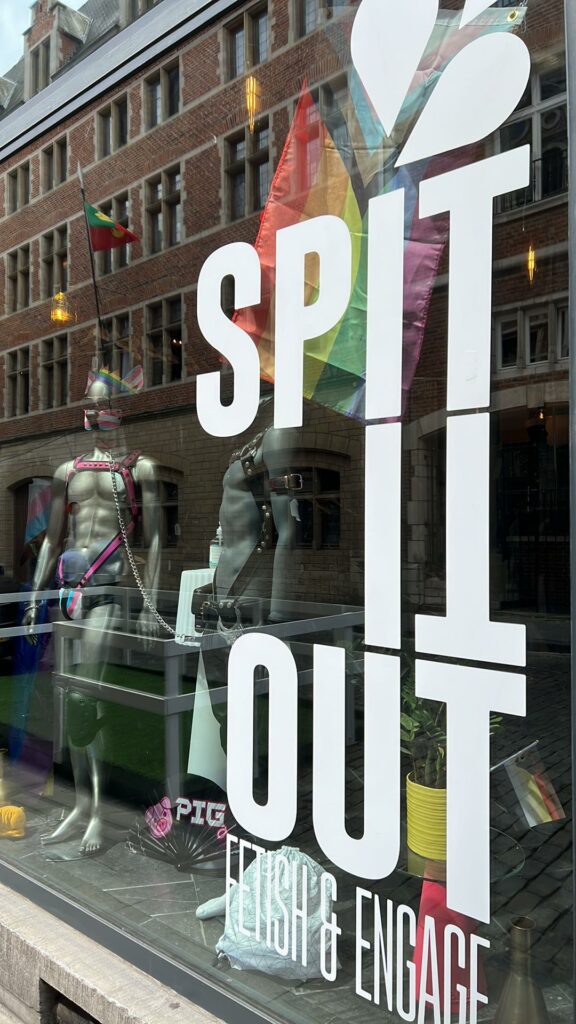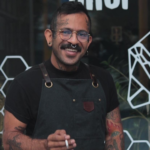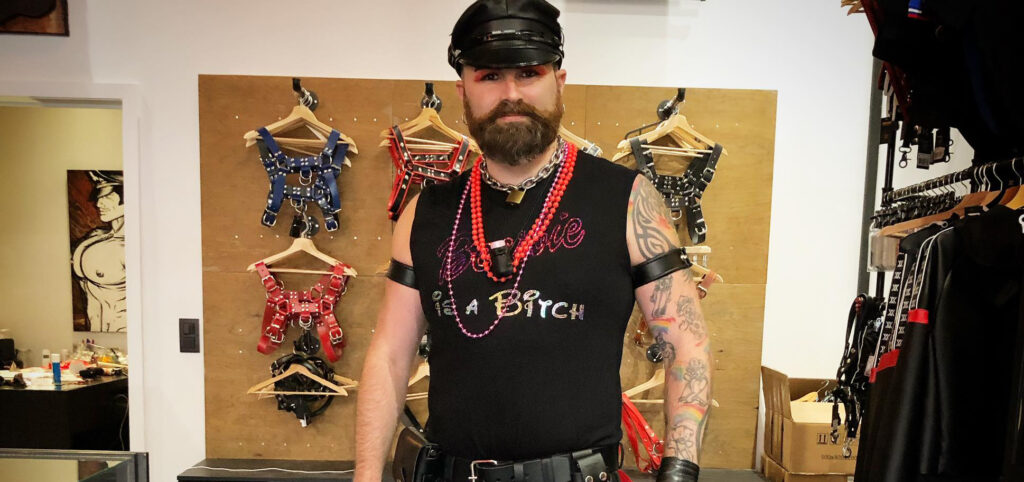As his eyes catch the window, the man stops. He takes his phone out, a smile full of uneasiness on his face. The showcase of Spit It Out! with its mannequins wearing harnesses, leather pants and puppy masks makes him giggle.
Kriss Stephany, the owner of shop, is used to this kind of reaction. He often hears passers-by mentioning that this is a shop for “perverse people”. When he gets the chance, he only answers these comments with one question: “And you, what is your perversion?”
Two decades ago, such a well-established fetish shop in the very centre of Brussels – Spit It Out! is located a mere 100 meters from the Grand Place – might have been unthinkable. But today, the fetish community has come into the light. And it has opened its doors widely. I sat with Kriss to discuss these evolutions.
Under the fetish umbrella
As a novice, I was first eager to discover what is commonly covered by the fetish umbrella. For Kriss, there are two intertwined branches. The first one includes the fetish for materials used to produce outfits and equipment such as leather, latex, neoprene, or lycra.
The second branch covers a broad range of erotic practices such as role play, puppy play, bondage, domination, submission, and sadomasochism (BDSM). All these practices imply a set of rules and a deep respect for the partners. People – such as people of colour or trans people – are not fetishes.
That said, Kriss considers that the fetish community goes way beyond exploring a taste for a type of material or for sensual and sexual practices. He sees it as a fully developed culture centred on the exploration of the self. Fetishism is not so much an experience as it is a way of life.
“Fetishism offers an approach and a relationship to the body, to affection and to sexuality outside the heteronormative framework”, adds Kriss. “A path to get to know yourself better, one that can bring you inner peace”.
While the passer-by laughs at the window shop, Kriss throws a sad look outside. “Seeing this culture mocked and reduced as a kind of folklore is a bit depressing”, he confides. Yet, that is exactly what gives him extra motivation.
“This shop is not a sex shop, it’s a fetish shop. I conceived it as a safe space open to all. A place to discuss sexuality beyond the heteronormative expectations. A place of understanding and kindness. A place where anyone can express themselves and be heard.” This inclusivity goes a long way.
Roots and evolutions
The fetish community finds its roots in the leather community that emerged after the second world war. Opposing the stereotype of the effeminate homosexual, this community first gathered gay men expressing their masculinity dressed in leather and riding motorbikes.
At a time when homosexual acts still constituted a criminal offence in most countries and homosexuality was seen as a mental disorder, the community started to structure itself around motorcycle clubs in the 1950s. The MS Belgica, known today as the MSC Belgium, was first established in 1971.
In the 1970s, the leather community was thriving. It had created a new stereotype for gay men – immortalised by the artistic drawings of Tom of Finland. It was also inventing a code to facilitate the identification of partners for sexual and BDSM practices in bars, public toilets, and other cruising areas.
The handkerchief code – or hanky code – was based on the use of coloured bandanas placed in the back pockets of the pants. The pocket the bandana was in signified the role – left for active/dominant and right for passive/submissive. The colour of the fabric signified what you were into – blue for anal sex, red for fisting, black for BDSM or yellow for water-sports.
The 1970s also mark the first opening in the leather community when lesbian women in San Francisco started to integrate gay men’s organisations or to create their own – such as Samois in 1978 or Dykes on Bikes in 1979.
At the beginning of the 1980s, the leather community was starting to diversify, giving birth to new branches such as a more BDSM-oriented community or the community known today as the bear community. This is when AIDS hit. And it hit the fetish community hard.
Recovering from the epidemic, the LGBTQ community turned during the 1990s towards a more assimilationist approach, where LGBTQ people were supposed to fit the norms of the heteronormative world to be accepted. Members of the fetish community were expected to hide. Their presence at Pride marches was considered by some as too provocative, and “counterproductive”.
In the last two decades, this attitude changed slowly, especially in Belgium. Leaders of the fetish community kept on sharing its history and culture. And the community opened in ways it had never before.
It embraced a more intersectional approach and welcomed women, people of colour, transgender people, and all variations of masculinity. Stereotypes were getting deconstructed at the same time as everyone accessed all types of material and practices.
The expectations in the role play previously linked to body characteristics, gender identity or sexual orientation are now being challenged. Outfits and equipment, though retaining part of the former colour code, are evolving to fit all kinds of bodies. And they are influence by what has been labelled “fetish fashion”.
Kriss welcomes the current evolution, as the progress rainbow flag in his storefront confirms. He is fully engaging into it though he acknowledges that he needed time and effort to educate himself.
At the beginning of May, he was glad to see the diversity of people attending Darklands, a 4-day fetish festival that took place in Antwerp. From 17 May, he welcomes into his shop GENI+AL YX – a pop-art exhibition deconstructing the links between gender identities and sex characteristics.

Yet, all these evolutions create frictions within the community. What is known as the “old guard”, keeps the culture of the first leather and bikers’ clubs alive. Some well-known fetish brands are still struggling to adapt their products. And the titles within the community – Mister Fetish, Mister Leather, or Mister Rubber – are not yet gender-neutral, with the exception of Puppy Belgium.
Tips to explore
For an outsider like me, the fetish community looks a bit intimidating. I turned to Kriss for advice on how to get past the apprehension.
“With regards to practices, the best is to talk and share with people who know the movement and its culture.”
For trusted individuals to turn to, check out Brussels Fetish United online. Go to safe spaces such as Stammbar. On the first Monday of the month, join the dedicated meeting “Ask Ken” to get information on the fetish community at La Réserve.
“Don’t forget that the key word is consent, consent, consent. It is important to understand that the practices have rules and codes”, notes Kriss.
Domination, for example, is a role that requires a lot of respect for the partner. It has very little to do with toxic masculinity as it is often portrayed.
“For the materials, the only way is to try, to smell, to feel, to wear. You need to immerse yourself in the material. You have to experience the struggle in getting into some of the outfits”.
Kriss invites everyone to visit his shop and try, even if you don’t buy anything. “We created here a space when you can talk, be comfortable and try without any pressure”.
“If I can help one person discover and find themselves, then I consider that I have done a great job”, concludes Kriss.
If you are curious and want to explore, know that you will always be welcome at Spit It Out!

You may also like
-

Bucharest, a capital that reveals itself with an open heart
When Léon, a history and culture enthusiast, and Edward, a design aficionado and nightlife devotee,
-

L’Abeille Blanche: Ink, Art & Inclusivity in the Heart of Brussels
L’Abeille Blanche is a collective and safe, LGBTQIA+ friendly space designed to promote artists across
-

Pierre Marcolini’s Valentine’s collection celebrates love in all it forms
Brussels-based chocolatier Pierre Marcolini has unveiled its Valentine’s collection with a beautiful message: “Celebrate love in all its shapes.” The campaign,
-

Thomas from 2BE Brussels : From a dream to a thriving reality
Thomas is a passionate entrepreneur who turned his love for fashion into a successful venture.
-

William R. Brito A.K.A. Weshmagul’s tattoos
Tattoo artist Weshmagul’s work is often inspired by Manga and Anime, pop culture, and queer

